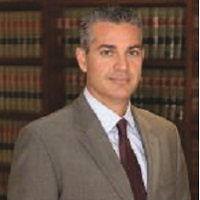By EB5 Investors Magazine Staff
EB5 Investors Magazine is pleased to announce the Top Litigation Attorneys. To be eligible, distinguished attorneys needed to perform litigation and related legal services for the EB-5 program.
For more information or to contact any of these professionals, we invite you to view their listings at www.EB5Investors.com/directories.
SCOTT ANDERSEN
ANDERSEN, P.C. | PRINCIPAL

Scott Andersen is principal at Andersen, P.C., a securities regulatory and defense law firm. Andersen was formerly deputy regional chief counsel at FINRA, where he oversaw all FINRA enforcement cases prosecuted by the Los Angeles office. Andersen has broad experience with regulatory investigations and enforcement actions as a 19-year plus securities regulator. He has led complex criminal and civil prosecutions for the N.Y. state attorney general’s office, the NYSE and FINRA. He has represented EB-5 participants, including a regional center, EB-5 issuer and a market intermediary in investigations conducted by the SEC and FINRA.
WHAT TRENDS ARE YOU SEEING WHEN IT COMES TO EB-5 LITIGATION?
The SEC and other regulators continue to have great interest in the EB-5 space to ensure compliance with the federal securities laws. The SEC is focused on whether EB-5 offerings are properly registered with the SEC or meet an exemption to registration. The SEC also continues to review offerings for fraud, including ensuring that investment proceeds are being properly utilized, as well as probing offerings for unregistered broker-dealer activity. FINRA is closely monitoring its broker-dealer members and their associated persons for compliance with these issues as well as applicable FINRA rules such as suitability, AML, advertising, due diligence and supervision.
WHY DID YOU GET INVOLVED IN THE EB-5 INDUSTRY AND WHAT DO YOU HOPE TO ACHIEVE?
The EB-5 Immigrant Investor Program provides overseas persons who invest in the U.S. a potential path to becoming a U.S. resident. I was immediately attracted to the program and quickly understood that many immigration and real estate professionals involved in EB-5 programs did not have sufficient experience with U.S. securities laws and regulations. I was interested in helping participants understand the applicable requirements to ensure their securities offering complied with all statutes and rules. Often this involves addressing errors previously made to bring a program into compliance with applicable U.S. securities laws.
BOB CORNISH
WILSON ELSER MOSKOWITZ EDELMAN & DICKER LLP | ATTORNEY
 Bob Cornish is a securities attorney in Washington, D.C., with AmLaw 100–member Wilson Elser. For nearly 25 years, Cornish has participated in cutting–edge securities litigation matters for institutional investors, family offices and industry participants. Among such matters include his work in the liquidation and reorganization of bankrupt broker-dealers, FINRA and SEC enforcement proceedings, as well as the mediation and arbitration of securities–related disputes. In the EB-5 arena, he has been a leader in developing dispute resolution solutions for regional centers and investors, including litigation funding. Cornish is a member of the EB-5 Securities Roundtable and AV rated by Martindale-Hubbell.
Bob Cornish is a securities attorney in Washington, D.C., with AmLaw 100–member Wilson Elser. For nearly 25 years, Cornish has participated in cutting–edge securities litigation matters for institutional investors, family offices and industry participants. Among such matters include his work in the liquidation and reorganization of bankrupt broker-dealers, FINRA and SEC enforcement proceedings, as well as the mediation and arbitration of securities–related disputes. In the EB-5 arena, he has been a leader in developing dispute resolution solutions for regional centers and investors, including litigation funding. Cornish is a member of the EB-5 Securities Roundtable and AV rated by Martindale-Hubbell.
WHAT TRENDS ARE YOU SEEING WHEN IT COMES TO EB-5 LITIGATION?
The wave of popularity in EB-5 has created litigation challenges for both investors and industry participants. Many are facing issues as creditors (and perhaps debtors) in U.S. bankruptcy courts, which by their nature complicate the litigation precepts upon which decisions are customarily made. This dynamic has led to people seeking counsel as the members of a group of litigants, rather than individually, to preserve assets and perhaps immigration benefits with a particular emphasis on cost sensitivity. This will not only continue in the area of failed or troubled projects, but also for those projects facing redeployment issues caused by retrogression.
WHY DID YOU GET INVOLVED IN THE EB-5 INDUSTRY AND WHAT DO YOU HOPE TO ACHIEVE?
I had the pleasure of being introduced to the concept of EB-5 by my former colleague and good friend, Rana Jazayerli, a well-known immigration attorney in Washington, D.C. My former law firm was looking to grow its base of work into immigration but was hesitant to do so. When we met Rana, the entire securities world of EB-5 seemed to appear right before our eyes. I was particularly intrigued about the convergence of securities law and immigration, and saw many opportunities to apply my skills as an attorney and compliance professional in the EB-5 arena.
IRA KURZBAN
KURZBAN, KURZBAN, TETZELI & PRATT P.A. | PARTNER
 Ira Kurzban was retained by one of the first EB-5 regional centers to represent individual investors and has since spent the last 20 years involved in the program. Today, Kurzban, Kurzban, Tetzeli & Pratt P.A. is a go-to immigration litigation firm. Kurzban has been a partner in the firm’s Miami office for over three decades and is the chair of the immigration department. Ira and his team handle more than 90 percent of all federal litigation cases for the EB-5 Immigrant Investor Visa program. Kurzban has been listed for over 35 years in the Best Lawyers in America.
Ira Kurzban was retained by one of the first EB-5 regional centers to represent individual investors and has since spent the last 20 years involved in the program. Today, Kurzban, Kurzban, Tetzeli & Pratt P.A. is a go-to immigration litigation firm. Kurzban has been a partner in the firm’s Miami office for over three decades and is the chair of the immigration department. Ira and his team handle more than 90 percent of all federal litigation cases for the EB-5 Immigrant Investor Visa program. Kurzban has been listed for over 35 years in the Best Lawyers in America.
WHAT TRENDS ARE YOU SEEING WHEN IT COMES TO EB-5 LITIGATION?
Today and in the near future, there will undoubtedly be more litigation by investors dissatisfied with USCIS policies as well as the actions of bad actors in a limited number of regional centers and new commercial enterprises. We are seeing the rise of SEC involvement in the field; the challenges brought about by delays in adjudications; the age-out process of children due to the method of counting derivatives in the EB-5 category; and the unreasonable interpretations of “at-risk,” “redemption agreements,” “ job creation” and “investment.” All of these challenges will lead to further litigation in the near term.
WHY DID YOU GET INVOLVED IN THE EB-5 INDUSTRY AND WHAT DO YOU HOPE TO ACHIEVE?
EB-5 has been an exciting intellectual and strategic challenge because it is an emerging and constantly changing area of immigration law. For example, we recently filed a lawsuit to challenge the way in which spouses and children are counted for visa purposes in the EB-5 category. No one previously challenged the concept that derivative family members in the EB-5 context must be issued separate visas when counting their investor spouse. Congress mandated that 10,000 visas should be issued to investors, yet the majority of visas go to spouses and children. Our lawsuit may dramatically effect visa allocation in the future.
JOHN P. PRATT
KURZBAN, KURZBAN, TETZELI & PRATT P.A. | PARTNER
 John P. Pratt is a partner at Kurzban, Kurzban, Tetzeli & Pratt P.A. He has a bachelor’s degree from Florida State University and a juris doctor from Tulane University. He has admitted to bar in Florida, New York and Washington, D.C., as well as various federal district and appellate courts. He serves on the board of governors for the American Immigration Lawyers Association, is AV rated by Martindale-Hubbell and is certified by the Florida Bar in immigration and nationality law. He concentrates in all areas of immigration and nationality law, including complex EB-5 federal court litigation.
John P. Pratt is a partner at Kurzban, Kurzban, Tetzeli & Pratt P.A. He has a bachelor’s degree from Florida State University and a juris doctor from Tulane University. He has admitted to bar in Florida, New York and Washington, D.C., as well as various federal district and appellate courts. He serves on the board of governors for the American Immigration Lawyers Association, is AV rated by Martindale-Hubbell and is certified by the Florida Bar in immigration and nationality law. He concentrates in all areas of immigration and nationality law, including complex EB-5 federal court litigation.
WHAT TRENDS ARE YOU SEEING WHEN IT COMES TO EB-5 LITIGATION?
There will be an increase in litigation by regional centers, projects and/or investors based on shifting and undefined USCIS policies, inconsistent adjudications, and I-526/I-829 USCIS arbitrary and incorrect legal and factual denials. In addition, there will be an increase in litigation by investors against projects due to bad acts, redeployment/management decisions, and other civil commercial actions. There will be a coordinated effort between civil commercial litigators and immigration law litigators to protect investor’s interests and overcome or prevent adverse USCIS EB-5 adjudications. Additionally, there is a trend of increased litigation representing investors in USCIS I-829 denied petitions in removal proceedings.
WHY DID YOU GET INVOLVED IN THE EB-5 INDUSTRY AND WHAT DO YOU HOPE TO ACHIEVE?
I started my involvement because I was litigating complex immigration cases in federal courts. Also, when I started my career with Ira Kurzban, we were litigating complex EB-5 cases, which eventually lead to the only federal court circuit decision in EB-5, Chang v. U.S., 327 F.3d 911. EB-5 involves complex corporate, securities, immigration and job economic methodologies issues that are challenging. In addition, federal court litigation is very rewarding because it can achieve amazing results, such as overcoming denials, and is the best mechanism to restrict USCIS from arbitrary adjudications that do not conform to facts, the statute or regulations.
RUSSELL C. WEIGEL III
INVESTMENTATTORNEYS | PRESIDENT
 Author of “Capital for Keeps,” a capital raise planning book for entrepreneurs, Russell C. Weigel, III, is a securities attorney and lecturer on private placements and other securities law issues. Weigel worked for the SEC’s Division of Enforcement for more than 10 years, having served in investigative, litigation and management capacities. Weigel’s law firm, InvestmentAttorneys, specializes in securities law, including the preparation of EB-5 transactional documents and the litigation of EB-5-related securities claims. Weigel earned his B.A. from Vanderbilt University and his J.D. from the University of Miami School of Law in 1989. Weigel is AV rated by Martindale-Hubbell.
Author of “Capital for Keeps,” a capital raise planning book for entrepreneurs, Russell C. Weigel, III, is a securities attorney and lecturer on private placements and other securities law issues. Weigel worked for the SEC’s Division of Enforcement for more than 10 years, having served in investigative, litigation and management capacities. Weigel’s law firm, InvestmentAttorneys, specializes in securities law, including the preparation of EB-5 transactional documents and the litigation of EB-5-related securities claims. Weigel earned his B.A. from Vanderbilt University and his J.D. from the University of Miami School of Law in 1989. Weigel is AV rated by Martindale-Hubbell.
WHAT TRENDS ARE YOU SEEING WHEN IT COMES TO EB-5 LITIGATION?
In 2018 I am starting to see investors in EB-5 projects suing the project developer without there having been a government lawsuit filed. In the past, investors were not organized or informed, and if they sued it was usually after a government action had been brought against the promoter of the EB-5 investment opportunity. The sophistication of the EB-5 investor has increased in recent years, which has pressured deal promotors to present better designed redeployment and exit strategies and more competitive returns-on-investment. However, older deals are at greater risk of being reviewed by investors who are now better educated.
WHY DID YOU GET INVOLVED IN THE EB-5 INDUSTRY AND WHAT DO YOU HOPE TO ACHIEVE?
The EB-5 industry is attractive because it can present a perfect storm: a wealthy foreign investor who may not have investment experience or U.S. legal system knowledge, developers in need of capital who have never before raised capital from equity investors, and a two-tier system of securities regulation that has hundreds of statutes and regulations to be mindful of, important gray areas where the regulations are silent, and harsh consequences (including substantial jail time) for purported wrongdoers. Making the USA a safer place to do business and invest and keeping the government out of my clients’ affairs are my objectives.
DISCLAIMER: The views expressed in this article are solely the views of the author and do not necessarily represent the views of the publisher, its employees. or its affiliates. The information found on this website is intended to be general information; it is not legal or financial advice. Specific legal or financial advice can only be given by a licensed professional with full knowledge of all the facts and circumstances of your particular situation. You should seek consultation with legal, immigration, and financial experts prior to participating in the EB-5 program Posting a question on this website does not create an attorney-client relationship. All questions you post will be available to the public; do not include confidential information in your question.







